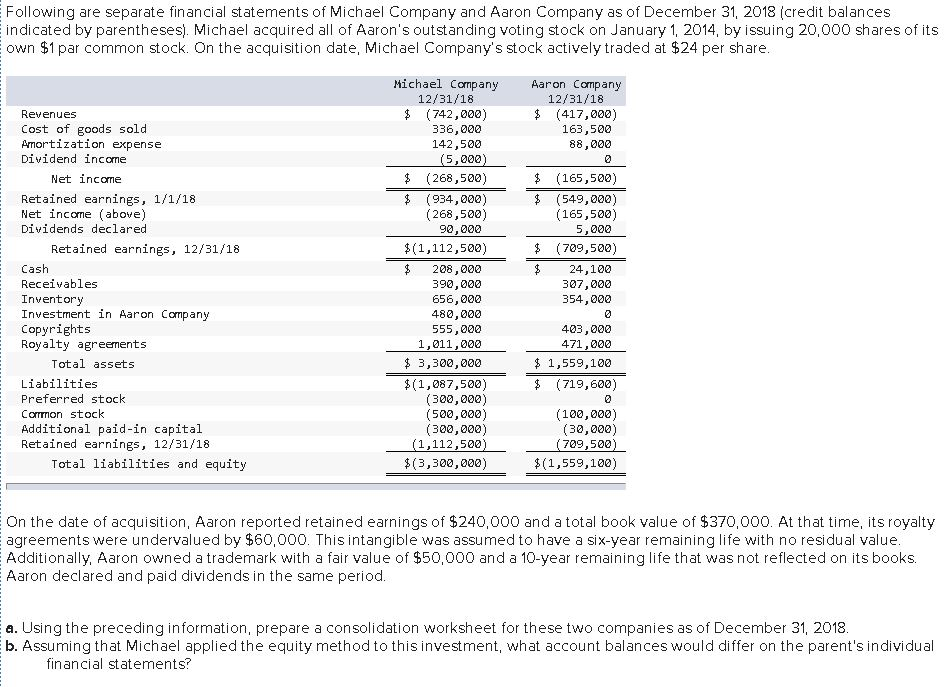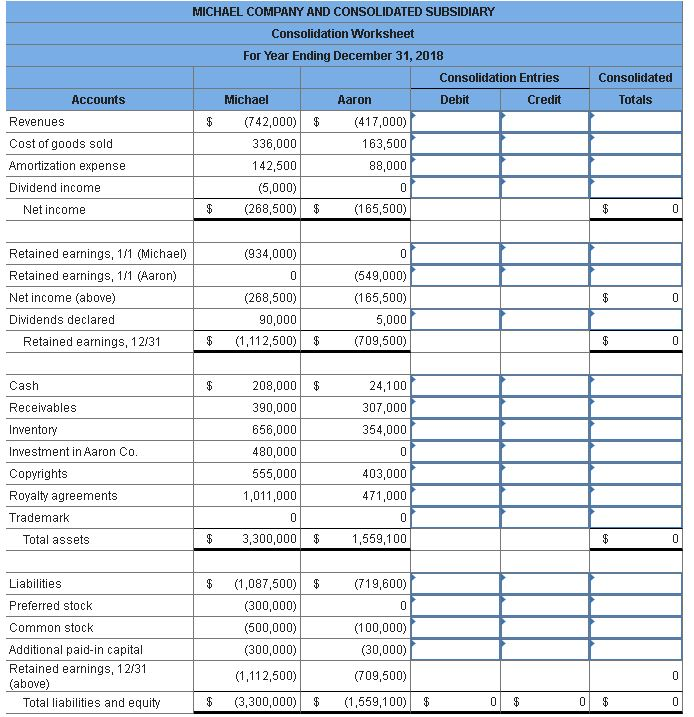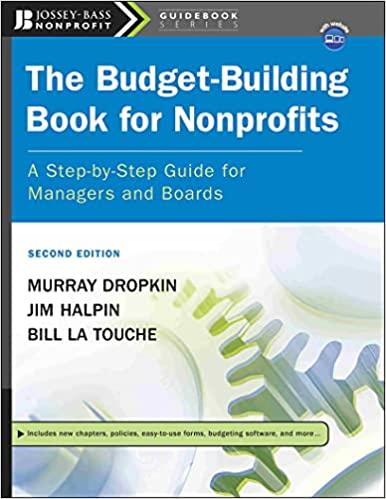


Following are separate financial statements of Michael Company and Aaron Company as of December 31, 2018 (credit balances indicated by parentheses). Michael acquired all of Aaron's outstanding voting stock on January 1, 2014, by issuing 20,000 shares of its own $1 par common stock. On the acquisition date, Michael Company's stock actively traded at $24 per share. Michael Campany Aaron Company 12/31/18 12/31/18 (742,000) 336,000 142,500 (5,000) (268,500) (417,000) 163,500 Revenues Cost of goods sold Amortization expense 88,000 Dividend income (165,500) Net income Retained earnings, 1/1/18 Net income (above) (934,000) (268,500) 90,000 $ (549,000) (165,500) 5,000 (709,500) Dividends declared (1,112,500) Retained earnings, 12/31/18 Cash 208,000 390,000 656,000 480,000 24,100 307,000 354,000 Receivables Inventory Investment in Aaron Company Copyrights Royalty agreements 555,000 1,011,000 403,000 471,000 $ 3,300,000 Total assets 1,559,100 Liabilities $(1,087,500) (300,000) (500,000) (300,000) (1,112,500) (3,300,000) (719,600) Preferred stock Common stock Additional paid-in capital Retained earnings, 12/31/18 Total liabilities and equity (100,000) (30,000) (709,500) $(1,559,100) On the date of acquisition, Aaron reported retained earnings of $240,000 and a total book value of $370,000. At that time, its royalty agreements were undervalued by $60,000. This intangible was assumed to have a six-year remaining life with no residual value. Additionally, Aaron owned a trademark with a fair value of $50,000 and a 10-year remaining life that was not reflected on its books. Aaron declared and paid dividends in the same period. a. Using the preceding information, prepare a consolidation worksheet for these two companies as of December 31, 2018 b. Assuming that Michael applied the equity method to this investment, what account balances would differ on the parent's individual financial statements? MICHAEL COMPANY AND CONSOLIDATED SUBSIDIARY Consolidation Worksheet For Year Ending December 31, 2018 Consolidation Entries Consolidated Debit Totals Accounts Michael Aaron Credit Revenues (742,000) (417,000) Cost of goods sold 336,000 163,500 Amortization expense 142,500 88,000 Dividend income (5,000) 0 (268,500) (165,500) O Net income Retained earnings, 1/1 (Michael) (934,000) 0 Retained earnings, 1/1 (Aaron) (549,000) Net income (above) (268,500) (165,500) Dividends declared 5,000 90,000 (1,112,500) Retained earnings, 12/31 (709,500) 208,000 $ Cash 24,100 390,000 Receivables 307,000 Inventory 656,000 354,000 Investment in Aaron Co. 480,000 0 Copyrights 555,000 403,000 Royalty agreements 1,011,000 471,000 Trademark 0 0 3,300,000 $ 1,559,100 Total assets Liabilities (1,087,500 (719,600) Preferred stock (300,000) 0 Common stock (500,000) (100,000) Additional paid-in capital (300,000) (30,000) Retained earnings, 12/31 (above) (1,112,500) (709,500) Total liabilities and equity (3,300,000) (1,559,100) 0 Required A Required B Assuming that Michael applied the equity method to this investment, what account balances would differ on the parent's individual financial statements? Following are separate financial statements of Michael Company and Aaron Company as of December 31, 2018 (credit balances indicated by parentheses). Michael acquired all of Aaron's outstanding voting stock on January 1, 2014, by issuing 20,000 shares of its own $1 par common stock. On the acquisition date, Michael Company's stock actively traded at $24 per share. Michael Campany Aaron Company 12/31/18 12/31/18 (742,000) 336,000 142,500 (5,000) (268,500) (417,000) 163,500 Revenues Cost of goods sold Amortization expense 88,000 Dividend income (165,500) Net income Retained earnings, 1/1/18 Net income (above) (934,000) (268,500) 90,000 $ (549,000) (165,500) 5,000 (709,500) Dividends declared (1,112,500) Retained earnings, 12/31/18 Cash 208,000 390,000 656,000 480,000 24,100 307,000 354,000 Receivables Inventory Investment in Aaron Company Copyrights Royalty agreements 555,000 1,011,000 403,000 471,000 $ 3,300,000 Total assets 1,559,100 Liabilities $(1,087,500) (300,000) (500,000) (300,000) (1,112,500) (3,300,000) (719,600) Preferred stock Common stock Additional paid-in capital Retained earnings, 12/31/18 Total liabilities and equity (100,000) (30,000) (709,500) $(1,559,100) On the date of acquisition, Aaron reported retained earnings of $240,000 and a total book value of $370,000. At that time, its royalty agreements were undervalued by $60,000. This intangible was assumed to have a six-year remaining life with no residual value. Additionally, Aaron owned a trademark with a fair value of $50,000 and a 10-year remaining life that was not reflected on its books. Aaron declared and paid dividends in the same period. a. Using the preceding information, prepare a consolidation worksheet for these two companies as of December 31, 2018 b. Assuming that Michael applied the equity method to this investment, what account balances would differ on the parent's individual financial statements? MICHAEL COMPANY AND CONSOLIDATED SUBSIDIARY Consolidation Worksheet For Year Ending December 31, 2018 Consolidation Entries Consolidated Debit Totals Accounts Michael Aaron Credit Revenues (742,000) (417,000) Cost of goods sold 336,000 163,500 Amortization expense 142,500 88,000 Dividend income (5,000) 0 (268,500) (165,500) O Net income Retained earnings, 1/1 (Michael) (934,000) 0 Retained earnings, 1/1 (Aaron) (549,000) Net income (above) (268,500) (165,500) Dividends declared 5,000 90,000 (1,112,500) Retained earnings, 12/31 (709,500) 208,000 $ Cash 24,100 390,000 Receivables 307,000 Inventory 656,000 354,000 Investment in Aaron Co. 480,000 0 Copyrights 555,000 403,000 Royalty agreements 1,011,000 471,000 Trademark 0 0 3,300,000 $ 1,559,100 Total assets Liabilities (1,087,500 (719,600) Preferred stock (300,000) 0 Common stock (500,000) (100,000) Additional paid-in capital (300,000) (30,000) Retained earnings, 12/31 (above) (1,112,500) (709,500) Total liabilities and equity (3,300,000) (1,559,100) 0 Required A Required B Assuming that Michael applied the equity method to this investment, what account balances would differ on the parent's individual financial statements









